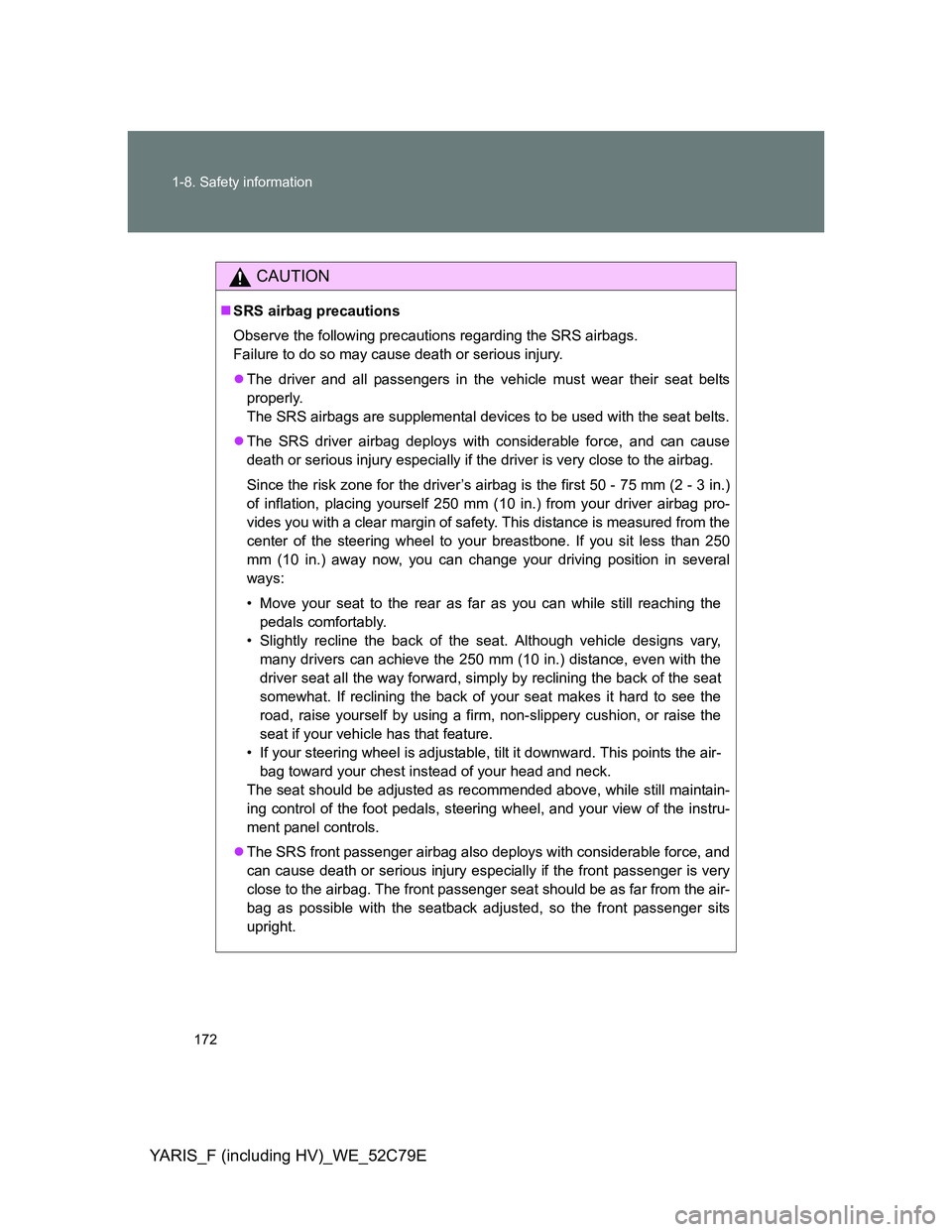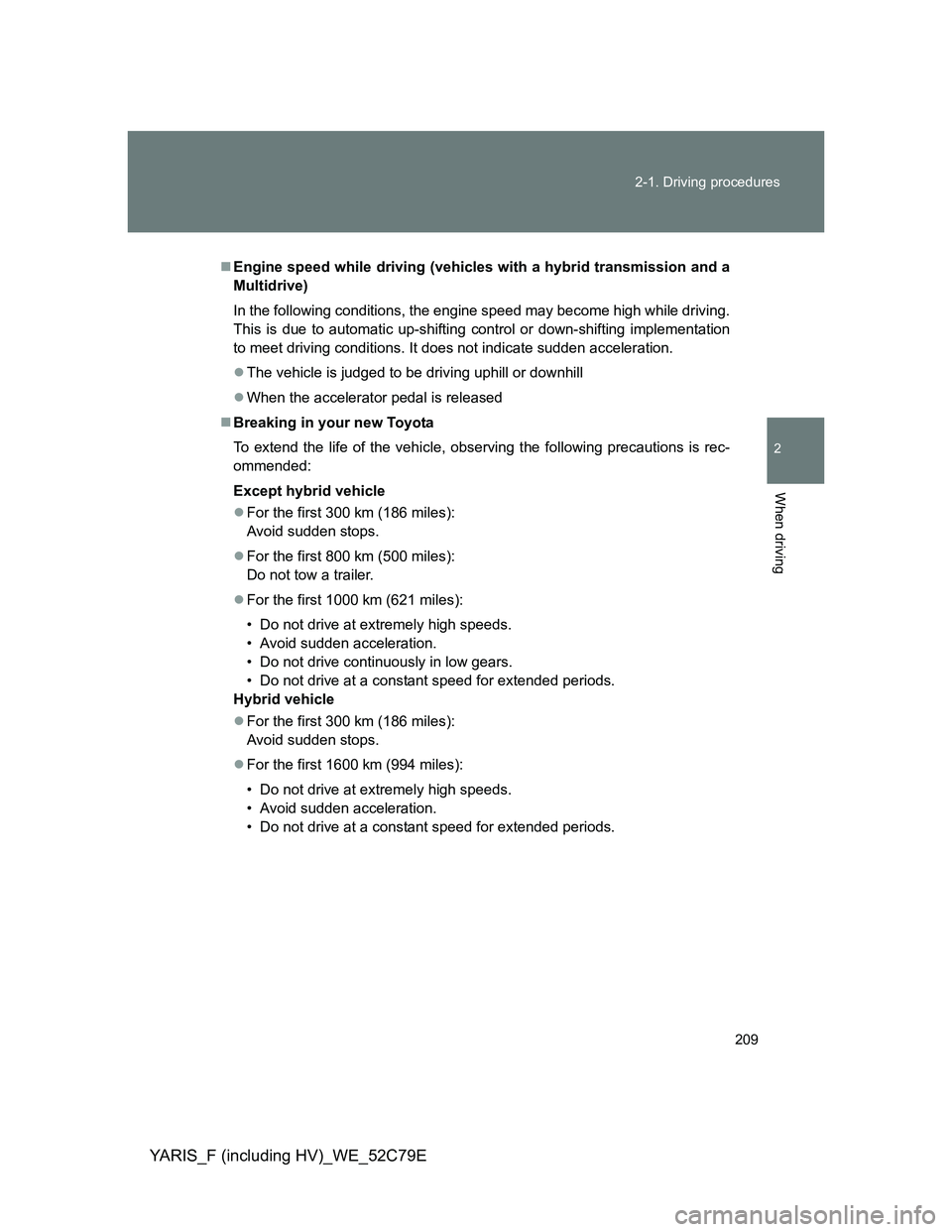Page 132 of 704
132 1-4. Adjustable components (seats, mirrors, steering wheel)
YARIS_F (including HV)_WE_52C79E
Adjusting the height of the front seat head restraints
Adjusting the rear seat head restraints
Always raise the head restraint one level from the stowed position when
using.
CAUTION
Head restraint precautions
Observe the following precautions regarding the head restraints. Failure to
do so may result in death or serious injury.
Use the head restraints designed for each respective seat.
Adjust the head restraints to the correct position at all times.
After adjusting the head restraints, push down on them and make sure
they are locked in position.
Do not drive with the head restraints removed.
Make sure that the head restraints are
adjusted so that the center of the head
restraint is closest to the top of your ears.
Page 134 of 704
134 1-4. Adjustable components (seats, mirrors, steering wheel)
YARIS_F (including HV)_WE_52C79E
Rear center seat belt
The rear center seat belt is a 3-point type restraint with 2 buckles.
Both seat belt buckles must be correctly located and securely latched
for proper operation.
Make sure that the buckle is
securely latched ready for use of
the center seat belt.
Matches the tab with hooked
end (tab “A”).
Matches the tab with concave
end (tab “B”).
Release method
The rear center seat belt can be completely released only when nec-
essary such as when folding down the rear seat.
To release the tab “B”, press
the release button.
To release the tab “A”, insert
the key or tab “B” into the hole
on the buckle.
Retract the belt slowly when
releasing and stowing the seat
belt.
A
B
A
A
B B
Page 135 of 704
135 1-4. Adjustable components (seats, mirrors, steering wheel)
1
Before driving
YARIS_F (including HV)_WE_52C79E
.Stow the seat belt tabs in the
cover set in the roof as shown.
Extracting the belt
Remove the tabs from the cover.
Page 172 of 704

172 1-8. Safety information
YARIS_F (including HV)_WE_52C79E
CAUTION
SRS airbag precautions
Observe the following precautions regarding the SRS airbags.
Failure to do so may cause death or serious injury.
The driver and all passengers in the vehicle must wear their seat belts
properly.
The SRS airbags are supplemental devices to be used with the seat belts.
The SRS driver airbag deploys with considerable force, and can cause
death or serious injury especially if the driver is very close to the airbag.
Since the risk zone for the driver’s airbag is the first 50 - 75 mm (2 - 3 in.)
of inflation, placing yourself 250 mm (10 in.) from your driver airbag pro-
vides you with a clear margin of safety. This distance is measured from the
center of the steering wheel to your breastbone. If you sit less than 250
mm (10 in.) away now, you can change your driving position in several
ways:
• Move your seat to the rear as far as you can while still reaching the
pedals comfortably.
• Slightly recline the back of the seat. Although vehicle designs vary,
many drivers can achieve the 250 mm (10 in.) distance, even with the
driver seat all the way forward, simply by reclining the back of the seat
somewhat. If reclining the back of your seat makes it hard to see the
road, raise yourself by using a firm, non-slippery cushion, or raise the
seat if your vehicle has that feature.
• If your steering wheel is adjustable, tilt it downward. This points the air-
bag toward your chest instead of your head and neck.
The seat should be adjusted as recommended above, while still maintain-
ing control of the foot pedals, steering wheel, and your view of the instru-
ment panel controls.
The SRS front passenger airbag also deploys with considerable force, and
can cause death or serious injury especially if the front passenger is very
close to the airbag. The front passenger seat should be as far from the air-
bag as possible with the seatback adjusted, so the front passenger sits
upright.
Page 174 of 704

174 1-8. Safety information
YARIS_F (including HV)_WE_52C79E
CAUTION
SRS airbag precautions
Do not allow anyone to kneel on the
passenger seat toward the door or put
their head or hands outside the vehicle.
Vehicles without a SRS driver knee air-
bag: Do not attach anything to or lean
anything against areas such as the
dashboard or steering wheel pad.
These items can become projectiles
when the SRS driver and front passen-
ger airbags deploy.
Vehicles with a SRS driver knee airbag:
Do not attach anything to or lean any-
thing against areas such as the dash-
board, steering wheel pad and lower
portion of the instrument panel.
These items can become projectiles
when the SRS driver, front passenger
and driver knee airbags deploy.
Vehicles without SRS curtain shield air-
bags: Do not attach anything to areas
such as a door, windshield glass and
side door glass.
Vehicles with SRS curtain shield air-
bags: Do not attach anything to areas
such as a door, windshield glass, side
door glass, front or rear pillar, roof side
rail and assist grip. (Except for the
speed limit label P. 601)
Page 203 of 704

2When driving
203
YARIS_F (including HV)_WE_52C79E
2-1. Driving procedures
Driving the vehicle ............ 204
Engine (ignition) switch
(except hybrid vehicle
[vehicles without a smart
entry & start system])...... 224
Engine (ignition) switch
(except hybrid vehicle
[vehicles with a smart
entry & start system])...... 228
Engine (ignition) switch
(hybrid vehicle [vehicles
without an electronic
key]) ................................ 238
Power (ignition) switch
(hybrid vehicle [vehicles
with an electronic key]) ... 243
EV drive mode
(hybrid vehicle) ............... 250
Hybrid transmission .......... 252
Multidrive .......................... 255
Multi-mode manual
transmission ................... 260
Manual transmission......... 265
Turn signal lever ............... 269
Parking brake ................... 271
Horn .................................. 272
2-2. Instrument cluster
Gauges and meters .......... 273
Indicators and warning
lights ............................... 278
Multi-information display ... 2862-3. Operating the lights and
wipers
Headlight switch................ 293
Fog light switch ................. 302
Windshield wiper and
washer ............................ 304
Rear window wiper and
washer ............................ 309
2-4. Using other driving systems
Cruise control.................... 311
Speed limiter ..................... 315
Stop & Start system .......... 318
Driving assist systems ...... 326
Hill-start assist control
(hybrid vehicle) ............... 332
Diesel particulate filter
system ............................ 334
2-5. Driving information
Cargo and luggage ........... 336
Winter driving tips ............. 338
Trailer towing
(hybrid vehicle) ............... 342
Trailer towing (except hybrid
vehicle [except for
South Africa]) .................. 343
Page 209 of 704

209 2-1. Driving procedures
2
When driving
YARIS_F (including HV)_WE_52C79E
Engine speed while driving (vehicles with a hybrid transmission and a
Multidrive)
In the following conditions, the engine speed may become high while driving.
This is due to automatic up-shifting control or down-shifting implementation
to meet driving conditions. It does not indicate sudden acceleration.
The vehicle is judged to be driving uphill or downhill
When the accelerator pedal is released
Breaking in your new Toyota
To extend the life of the vehicle, observing the following precautions is rec-
ommended:
Except hybrid vehicle
For the first 300 km (186 miles):
Avoid sudden stops.
For the first 800 km (500 miles):
Do not tow a trailer.
For the first 1000 km (621 miles):
• Do not drive at extremely high speeds.
• Avoid sudden acceleration.
• Do not drive continuously in low gears.
• Do not drive at a constant speed for extended periods.
Hybrid vehicle
For the first 300 km (186 miles):
Avoid sudden stops.
For the first 1600 km (994 miles):
• Do not drive at extremely high speeds.
• Avoid sudden acceleration.
• Do not drive at a constant speed for extended periods.
Page 295 of 704
295 2-3. Operating the lights and wipers
2
When driving
YARIS_F (including HV)_WE_52C79E
Turning on the high beam headlights
With the headlights on, push
the lever away from you to
turn on the high beams.
Pull the lever toward you to the
center position to turn the high
beams off.
Pull the lever toward you and
release it to flash the high
beams once.
You can flash the high beams
with the headlights on or off.
Manual headlight leveling dial
The level of the headlights can be adjusted according to the number
of passengers and the loading condition of the vehicle.
Left-hand drive vehicles
Raises the level of the head-
lights
Lowers the level of the head-
lights